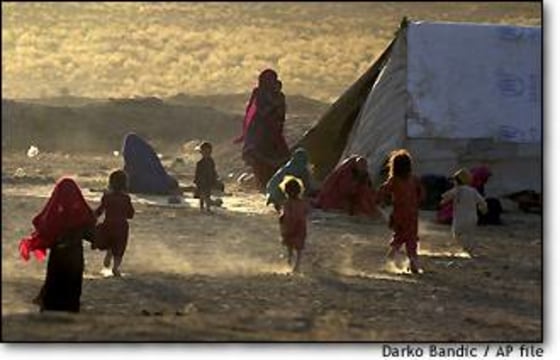Afghanistan, for years one of the world’s biggest sources of fleeing refugees, is now witnessing a dramatic reversal. In the wake of the Taliban’s fall, so many refugees have returned that they have vastly outstripped the resources of the agencies there to help them. Now, tens of thousands face a winter without jobs, or adequate food or shelter.
Early this year, as the U.S. military campaign moved into the mop-up phase, the push to repatriate Afghan refugees began. There were an estimated 3.7 million living outside the country, driven out by Cold War-era fighting with the Soviets, long-running ethnic fighting and finally the U.S.-led military campaign to destroy al-Qaida and oust the Taliban government.
The U.N. High Commission on Refugees, or UNHCR, which is heading up refugee work in partnership with the new Afghan government, estimated that some 1.2 million Afghans would need help getting resettled in 2002 — 800,000 returning from Pakistan and Iran, and another 400,000 moving home after being displaced within Afghanistan itself.
But the flood was far greater than expected. Already this year, more than 1.7 million Afghans have returned home, a number that the United Nations estimates will rise to 2 million before the end of the year. At high tide in early summer, the United Nations was processing more than 10,000 returnees a day.
The big surprise was the number of refugees returning from border camps in Pakistan as well many more who had blended into Pakistani society over the years. So far, 1.4 million have returned from Pakistan alone. Nearly 300,000 have returned from Iran, and some have come home after seeking refuge in Tajikistan.
Voting with their feet
U.S. officials and refugee workers insist it is a story of hope. The promise of a new life for their country, bolstered by billions of dollars in international aid, generated a wave of optimism among Afghans.
“In a sense, refugees are voting with their feet,” says John Frederikson of the Washington office of the High Commission on Refugees.
But in the short run, there is a serious shortage of funding and supplies to accommodate them. “The winter is coming up; there is a lack of work and challenges delivering food,” Frederikson said.
His agency may still achieve its original budget goal of $217 million for the year, but the organization has to stretch it to serve 80 percent more Afghans than expected.
To that end, the refugee commission has cut aid for transportation, and some health and education programs have been canceled. Temporary housing for returning Afghans originally was designed to have two rooms — to allow the separation of men and women in accordance with Muslim custom. The planned dwellings have been scaled back to just one room.
Tent cities have sprung up around Kabul, and Lakhdar Brahimi, the United Nations’ top representative on Afghanistan, has called on Pakistan and Iran to discourage more refugees from returning before winter, saying there is no way the country can settle them.
Meanwhile, UNHCR and human rights groups lashed out at European Union officials who announced in September, under heavy pressure from voters to stop illegal migration, a forced repatriation plan for some 100,000 Afghan refugees.
Winter looms, aid workers worry
By October, the flow of returnees had ebbed and wasn’t expected to rise with the onset of winter.
“In a sense, we have some breathing space to catch up,” says Frederikson.
But other observers have their doubts.
“With winter looming, we’re sort of in the same place that we were a year ago,” says Joel Charney, vice president for policy at Refugees International. Not only are there large food deficits, but the reconstruction of the country has proceeded at a snail’s pace, despite some by donor countries that attended a January conference on Afghanistan’s reconstruction. About $900 million has reportedly been delivered, and even that hasn’t gone as far as many had hoped.
“We’re asking the same question as the Afghan government,” says Charney. “Why has it taken so long to get reconstruction under way?”
Kabul's growing pains
The greatest concentration of returnees — about 600,000 — are in Kabul, even though many of them are originally from other parts of Afghanistan. The influx has added to the huge strain on the capital city, which was devastated by warring factions in the early 1990s. Housing, schools and basic services are all in short supply.
Frederikson says many Afghans are using the city as a staging area before returning to their rural homes. Others have become accustomed to urban life in the long years away from their country, integrated into major cities in Pakistan, such as Karachi and Islamabad.
Many are in the capital because it is the only part of the country protected by international security forces. For the moment, there is no plan to expand the peacekeeping force to other areas of the country.
In the south and east of Afghanistan, U.S.-led military forces are still trying to root out remnants of Osama bin Laden’s al-Qaida and Taliban stragglers. Elsewhere, regional , benefiting from the post-Taliban power void.
Lingering dangers
And there are hazards lingering from decades of conflict, including the latest U.S. bombing campaign — a countryside littered with unexploded ordnance and landmines.
It will take years, despite the largest demining operation in the world, to remove this threat to civilians.
“People would usually like to go and resettle where they are from,” says Charney. “They go back and see that their fields are destroyed, there’s no school for their kids and the local warlord is running amok. ... Their only choice is to go back to Pakistan or go to Kabul.”
Charney says that already some Afghans have gone back to refugee camps in Pakistan where conditions are better — men can get day work and the children can attend school.
According to one U.S. official, who spoke only on condition of anonymity, unless the situation in Afghanistan improves swiftly, there could be a mass outflow.
